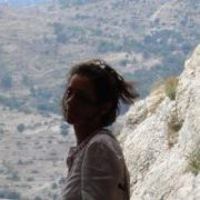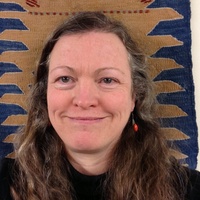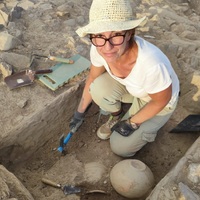
Leonor Rocha
Professor of Archaeology at Évora University.
His research interests include survey and excavation of Neolithic and Eneolithic sites in SW of the Iberian Peninsula, in settlements and megalithic sites
Address: Evora University
His research interests include survey and excavation of Neolithic and Eneolithic sites in SW of the Iberian Peninsula, in settlements and megalithic sites
Address: Evora University
less
Related Authors
Nerissa Russell
Cornell University
Arianna Traviglia
Istituto Italiano di Tecnologia / Italian Institute of Technology
Maurizio Forte
Duke University
David Seamon
Kansas State University
Marta Diaz-Guardamino
Durham University
Miljana Radivojević
University College London
Armando Marques-Guedes
UNL - New University of Lisbon
Julian Thomas
The University of Manchester
Stefano R L Campana
University of Siena / Università di Siena
Enrico Cirelli
Università di Bologna
InterestsView All (27)










Uploads
Papers by Leonor Rocha
In the work carried out during the 20th century, a significant set of monuments was identified and excavated, resulting in a very extensive collection of artefacts, namely idols and votive plaques. In the first two decades of the 21st century, new and important data emerged on this subject, essentially as a result of the work to minimise environmental impacts in progress in the Alentejo region, which made it possible to identify and characterise new funerary rituals, demonstrating a different behaviour towards death, especially regarding the presence of votive idols. The combination of all these data with absolute dating and pigment analysis, enables us to reach some interesting conclusions about spaces, architectures, grave goods and chronological sequences
actual location of each of the monuments, given that they were previously not correctly indicated.
With this new information, a geographic database including variables such as altitude, distance from water or visibility has been created. Preliminary results have established, among other things, their evolution in terms of the geographical location of the protomegaliths and larger dolmens, as well as also suggesting the importance of river courses and the commanding view of individual monuments over each river basin.
Recent work, carried out by the signatories within the framework of the municipal Archaeological Charter, has made it possible to see that the occupation of this place was much more complex, with the existence of a Neolithic settlement, but also with the presence of a very interesting set of open-air rock art, located in small open shelters or isolated rocks. In this paper we refer to the work that has been carried out and some of the problems identified.
Reconociendo el incuestionable valor que el conjunto megalítico alentejano representa en nuestro Patrimonio Cultural, intentamos en este trabajo presentar el estado de la cuestión y la problemática existente en torno a la investigación, salvaguarda y clasificación, en un momento en que el Ministerio de Cultura está abriendo un procedimiento para la clasificación de este conjunto, sin filtros.
and contemporary periods. Casa Cordovil is one of the old manor houses in the city of Évora, located in the southeast of the city, close to Largo das Portas de Moura, between Cerca Velha and Cerca Nova. This intervention, which arose from the need for the University of Évora to carry out rehabilitation and improvement work at Casa Cordovil, had two aspects, that of archaeological monitoring and the excavation of a silo identified in one of the open trenches.
In the work carried out during the 20th century, a significant set of monuments was identified and excavated, resulting in a very extensive collection of artefacts, namely idols and votive plaques. In the first two decades of the 21st century, new and important data emerged on this subject, essentially as a result of the work to minimise environmental impacts in progress in the Alentejo region, which made it possible to identify and characterise new funerary rituals, demonstrating a different behaviour towards death, especially regarding the presence of votive idols. The combination of all these data with absolute dating and pigment analysis, enables us to reach some interesting conclusions about spaces, architectures, grave goods and chronological sequences
actual location of each of the monuments, given that they were previously not correctly indicated.
With this new information, a geographic database including variables such as altitude, distance from water or visibility has been created. Preliminary results have established, among other things, their evolution in terms of the geographical location of the protomegaliths and larger dolmens, as well as also suggesting the importance of river courses and the commanding view of individual monuments over each river basin.
Recent work, carried out by the signatories within the framework of the municipal Archaeological Charter, has made it possible to see that the occupation of this place was much more complex, with the existence of a Neolithic settlement, but also with the presence of a very interesting set of open-air rock art, located in small open shelters or isolated rocks. In this paper we refer to the work that has been carried out and some of the problems identified.
Reconociendo el incuestionable valor que el conjunto megalítico alentejano representa en nuestro Patrimonio Cultural, intentamos en este trabajo presentar el estado de la cuestión y la problemática existente en torno a la investigación, salvaguarda y clasificación, en un momento en que el Ministerio de Cultura está abriendo un procedimiento para la clasificación de este conjunto, sin filtros.
and contemporary periods. Casa Cordovil is one of the old manor houses in the city of Évora, located in the southeast of the city, close to Largo das Portas de Moura, between Cerca Velha and Cerca Nova. This intervention, which arose from the need for the University of Évora to carry out rehabilitation and improvement work at Casa Cordovil, had two aspects, that of archaeological monitoring and the excavation of a silo identified in one of the open trenches.
of archaeological excavations, motivated by minimization and safeguard interventions, corresponded to a disinvestment in multi -annual archaeological research projects.
It is not uncommon for safety reasons that archaeological excavations carried out in the context of work do not offer the ideal conditions to be open to the public, interested in knowing the work of archaeologists. In
the same way, the evidence shows that the knowledge acquired in these works remains in the technical and scientific reports, barely adequate for the dissemination of knowledge among the interested public.
Another important issue relates to the management of the large volume of assets collected during archaeological interventions, which conflicts with the lack or lack of museums and sites dedicated to their exposure. These are kept under the ownership of the excavation directors or in government deposits, inaccessible to public enjoyment and knowledge.
on the Recent Prehistory, aim to study the genesis and evolution of the first peasant societies, an integrated perspective that considers, in general terms, all components of the life and death of these companies, by conducting
archaeological excavations and archaeological surveys.
The results of this work allow us to conduct a first assessment of its evolution (s), in Central Alentejo.
number of artefacts without proper archaeological context, which are nowadays stored in the Portuguese national museums.
During the last years, a systematic approach has been undertaken to study some exotic materials exhumed in some of those megalithic monuments. Using SEM-EDX, Raman spectroscopy and micro-XRD we were able to identify the chemical composition of the red pigments recovered in a selection of megalithic monuments form Alentejo. Cinnabar and ochre were identified alone or mixed in several monuments, but it is unknown if that mixture was done intentionally or not.
This study demonstrates the need to use the appropriate analytical methodology in order to
properly identify the nature of red pigments found in archaeological context.